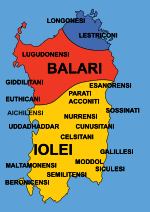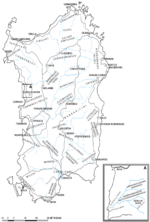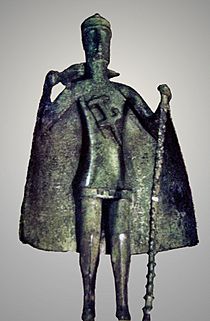Ilienses facts for kids
The Ilienses (also called Iolaes) were an ancient people who lived in central-southern Sardinia during the Bronze Age and Iron Age. They were one of the three main groups of ancient Sardinians, along with the Corsi and the Balares. When the Sicilian Wars started with the Punic invasion in the 500s BC, some Ilienses moved to the island's mountains. From there, they fought against foreign rule for many centuries.
Contents
History of the Ilienses


Myths About Their Origins
Ancient Greek historians shared stories about how the Ilienses got their name. One myth says their name, Iolaes, comes from Iolaus. He was a hero who led a group called the Thespiades to Sardinia. There, he started a new settlement.
Another story says that after the city of Troy fell, some people from Troy (also called Ilium) sailed to Sardinia. They settled there and mixed with the Iolaes. This is why they were called Ilienses. The ancient writer Pomponius Mela believed the Ilienses were the oldest people on the island.
A fourth part of the people was the army of Iolaus. They were from Thespiae and Attica, and they landed in Sardinia and founded Olbia. There are still places in Sardinia called Iolaia today, and Iolaus is honored by the people. When Troy was captured, some Trojans escaped with Aeneas. A part of them were blown off course by winds and reached Sardinia. They married the Greeks already living there (the Iolaes). But the non-Greek people (Balares?) were stopped from fighting the Greeks and Trojans. This was because both sides had equal fighting power. Also, the river Thorsus (Tirso) flowed between their lands, making both sides afraid to cross it.
—Pausanias, Description of Greece, 10.17

The Nuragic Period
Even with the myths, the Ilienses were most likely a group of people who were originally from Sardinia. According to archaeologist Giovanni Ugas, the Ilienses were the most important people of Nuragic Sardinia. He thought they were connected to the Sherden, one of the Sea Peoples mentioned in ancient Egyptian writings. However, other experts disagree with this idea.
Eduardo Blasco Ferrer, another expert, thinks their name comes from an ancient Iberian word, *ili-, which means "settlement." During the Nuragic period, the Ilienses lived in an area from the plain of Campidano (called the Iolean plain long ago) up to the Tirso river in the north. The land of the Balares began there.
The Ilienses were probably split into 40 tribes. Each tribe was led by a king or chieftain. These leaders lived in large, complex nuraghi, which are ancient stone towers. A famous example is Su Nuraxi in Barumini.
Many Mycenaean artifacts have been found in the Ilienses' old territory. This shows that these two ancient groups traded a lot. Also, Oxhide ingots have been found. These copper ingots might have come from Cyprus. They were found in places like Cagliari and the province of Ogliastra. Between 1300 and 1200 BC, a special gray pottery was made in central-southern Sardinia. Pieces of this pottery have been found in Kommos, Crete, and at Cannatello in Sicily.
Punic and Roman Times
Ancient writings, like those by Diodorus Siculus and Pausanias, show that the Ilienses strongly fought against the rule of Carthage starting in the 500s BC.
When the Carthaginians were at their strongest at sea, they defeated everyone in Sardinia except the Ilians (Ilienses) and Corsicans. These groups were saved from slavery by the strength of the mountains.
—Pausanias, Description of Greece, 10.17
After the First Punic War ended in 238 BC, the Romans took over the main Carthaginian strongholds in Sardinia. But the people living inland, including the Ilienses, continued to fight the new invaders.
In 227 BC, Corsica and Sardinia became the second Roman province. The start of the Second Punic War and Hannibal's victories in Italy caused new uprisings in Sardinia. After the Roman defeat at the Battle of Cannae, a Sardinian-Punic leader named Hampsicora, with help from the Carthaginians and Ilienses, started a new rebellion. In 215 BC, the rebels were defeated in the battle of Decimomannu by Titus Manlius Torquatus. After this, Carthage lost control of the island for good.
During Roman times, the Ilienses and the Balares in the interior kept resisting. In 177 BC, they were heavily defeated by the consul Tiberius Gracchus. About 80,000 Sardinians were killed or enslaved. However, even during the Roman Empire, they were not fully conquered by Rome. They continued to live somewhat independently in the central region called Barbagia.
Ilienses / Iolaes Tribes
- Acconites (Acconiti)
- Aechilenenses / Aichilenses (Aichilensi) / Cornenses / Cornenses Pelliti
- Aesaronenses / Aisaronenses (Esanorensi)
- Alcitani (Alkitani)
- Alticientes (Altikientes) / Altic(ienses)
- Barbaricini (Barbarikini) (in the region later known as Barbagia)
- Beronicenses (Beronikenses) (Beronicensi)
- Bulgares (Ilienses Bulgares)
- Campani (Patulcenses Campani)
- Caralitani (Carales, today's Cagliari, was in their territory)
- Carenses, they lived south of the Coracenses and north of the Salcitani and the Lucuidonenses.
- Celes(itani) / Celsitani, they lived south of the Rucensi and north of the Scapitani and the Siculensi.
- Corpicenses, they lived south of the Rucensi and north of the Scapitani and the Siculensi.
- Cunusitani / Cusin(itani), they lived south of the Coracenses and north of the Salcitani and the Lucuidonenses.
- Euthychiani (Euthicani) (they were not a tribe of the Balares)
- Fifenses
- Galillenses (Galillesi)
- Hypsitani
- Ilienses (Ilienses Proprii) / Iolei (Iolei Proprii) / Pelliti / Sardi Pelliti
- Lesitani
- Maltamonenses
- Martenses
- Mauri (Paleo-Sardinian tribe) (Mauri Ilienses), in an area of far southwestern Sardinia (they may have been a tribe related to or of Mauri origin that was assimilated by the Ilienses (Iolei))
- Moddol(...)
- Muthon(enses)
- Neapolitani, they lived north of the Sulcitani and the Noritani.
- Noritani / Norenses, they lived at the extreme south part of the island, immediately south of the Neapolitani and the Valentini (not to be confused with the Nurritani or Nurrenses)
- Nurrenses (Nurensi) (not to be confused with the Norenses or Noritani)
- Parati
- Patulcenses (not to be confused with the Patulcii or Patulci)
- Patulcii / Patulci (not to be confused with the Patulcenses)
- Rubrenses / Rubri / Rubrinses
- Rucenses (Rucensi), they lived south of the Æchilenenses (also called Cornenses) and north of the Celsitani and the Corpicenses
- Salcitani (Salkitani), they lived south of the Carenses and the Cunusitani and north of the Æsaronenses.
- Sarrapitani
- Scapitani, they lived south of the Celsitani and the Corpicenses and north of the Neapolitani and the Valentini
- Semilitenses (Semilitensi) / Maltamonenses (Maltamonensi)
- Siculenses (Siculesi), they lived south of the Celsitani and the Corpicenses and north of the Neapolitani and the Valentini. (may have been a tribe of Siculian or Sicel origin assimilated by the Ilienses or Iolei)
- Sossinates (Sossinati)
- Sulcitani / Solcitani, they lived at the extreme south part of Sardinia, immediately south of the Neapolitani and the Valentini
- Uterini
- Uthicenses / Uthikenses / Othocenses
- Valentini, they lived south of the Scapitani and the Siculensi and north of the Solcitani and the Noritani.
- Vitenses
- [...]rarri [Nu]misiaru[m]
See also
 In Spanish: Ilienses para niños
In Spanish: Ilienses para niños
- List of ancient Corsican and Sardinian tribes
- Balares (Balari)
- Corsi
- Paleo-Corsican language
- Paleo-Sardinian language
- History of Sardinia
- Nuragic civilization
- Sardinian people
- Torrean civilization
- Corsican people
- Ethnic group
- Tribe

